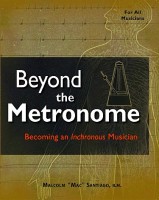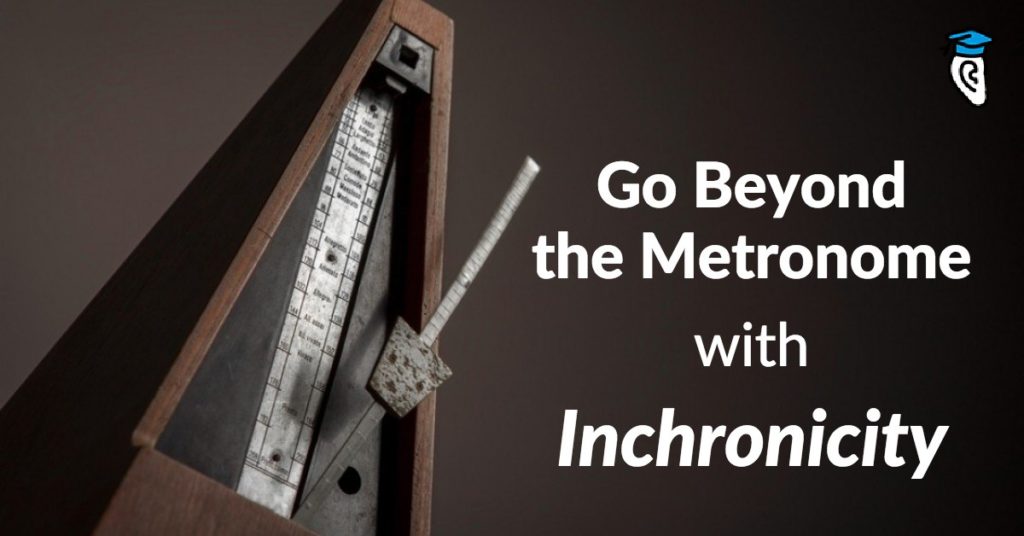Rhythm is a weak point for many musicians. Unless you are a percussionist (and even then!) it’s easy to ignore rhythmic precision and focus on which notes you are playing, instead of when. Yet a tightly-honed sense of rhythm allows you to sound professional, sync well with other musicians, and create a groove that draws your listeners in more deeply to your performance.
Recently we came across an innovative approach to developing better rhythm called Inchronicity and we invited its creator, Mac Santiago, to join us here for an interview.
Mac Santiago is a west coast musician based in the Minneapolis-St. Paul area where he as known both as a teacher and a truly versatile percussionist and accompanist. He has come up with some novel ways to develop better rhythm and shares them in his book Inchronicity which comes with downloadable practice tracks to help you put the lessons of the book into practice.
The struggle? I have my theories. Not enough dancing and incorporating body movement in time to music. I’ve worked with pros who literally cannot tap their foot in time while they play.
Modern culture doesn’t demand enough walking or repetitive movement in work. Western music and the Euro-classical tradition doesn’t really put enough emphasis on rhythm the way that music from the African diaspora does.
The result being that rhythm ends up playing “second fiddle” to harmony and melody. I could go on but these are just theories.
 The method was inspired by hearing young hardworking, well trained musicians who, in spite of being able to work well with clicks, struggled in actual performance much as I did surviving in the “school of hard knocks”.
The method was inspired by hearing young hardworking, well trained musicians who, in spite of being able to work well with clicks, struggled in actual performance much as I did surviving in the “school of hard knocks”.
My father, also a drummer, had always emphasized the importance of good solid tempo. I soon realized that time is something one needs to “own” with confidence.
Though most of the method is based on things that I have picked up from other players during my 40 year career, the most unique thing is the idea that one must “wean” oneself from the so called “tempo crutch” known as the metronome (or click track) in order to become a creator of groove.
Being a good follower of tempo is good because one needs to hear it in the music and be able to adjust it to what they are hearing in others or what they are being directed to do. But while in the moment, all the players are ultimately the time creators and are responsible for the tempo’s maintenance throughout the piece.
This allows one to stay in sync with others with the understanding that good tempo helps to determine the moment of attack and stating one’s phrases clearly…. Better ensemble! It works in the same way that good intonation makes harmonies and melodies sound clearer.
 Record and listen back. When someone tells you you are rushing or dragging, look at it as a teachable moment and don’t take time for granted. Listen for line-ups and try to detect when you are not in-sync with other players, whether on the beat or syncopated where the music requires it.
Record and listen back. When someone tells you you are rushing or dragging, look at it as a teachable moment and don’t take time for granted. Listen for line-ups and try to detect when you are not in-sync with other players, whether on the beat or syncopated where the music requires it.
Very important question. When relying on others to be the “timekeepers” you are always prone to affecting the time. For example, a poorly placed staccato hit on any instrument will always raise questions on where the groove is!
Everybody shares the responsibility.
Both. This is not an advanced skill! Like playing in tune, this is a skill that can be refined and “tuned up” throughout one’s career. As one challenges oneself to more complex music, rhythmic accuracy is paramount to judging a successful performance at any level. Your inchronous sense can always be refined as your technique changes and grows.
Definitely! Straight-up downloads seem as if they could create too much “sharing”. I would really like to turn the book into an app complete with the tracks playing infinitely with the ability to add more lessons and concepts as they arise! That takes money. Who knows? If the ideas I have presented catch on more I may be able to afford it.
How about two?
- Never turn your metronome higher than 40 bpm! ;-)
- A poorly-played note well placed is better than a well-played note placed poorly.
Thanks, Mac, for joining us on EasyEarTraining.com to share these insights on how and why musicians should consider an inchronous approach to developing good rhythm. You can learn more about Mac and Inchronicity, and buy the book with accompanying practice tracks at Inchronicity.com.



 Click to tweet
Click to tweet




